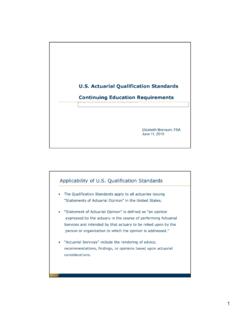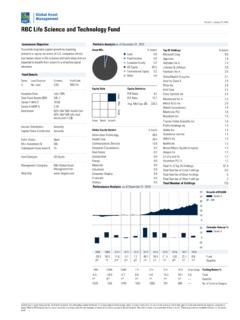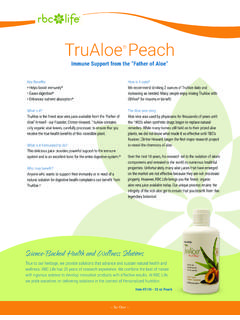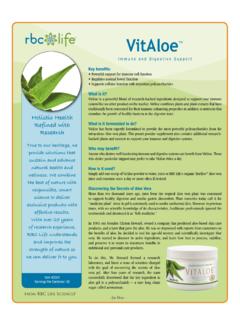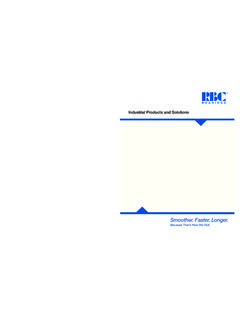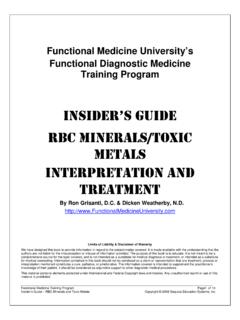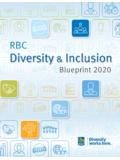Transcription of RBC S&P Sakib - ACSW
1 capital ManagementOutline NAIC Risk based capital Model Goals Formula Risk Categories RBC Level of Action C-3 Phase IIOutline S&P capital Model Description Formula S&P Rating Level Risk Categories ConclusionNAIC Risk based capital - Measures minimum amount of capital required to support overall business Considers the size and the degree of risk taken by the of NAIC RBC Requirement Universally recognized capital standard. Protection against short term adverse deviations. Prevents companies from taking extraordinary of NAIC RBC Requirement Assures interested parties that the risk of insolvency is low. Authorize regulators to enforce compliance with more capital Formula Estimate RBC levels required to manage losses that can be caused by a series of catastrophic financial events.
2 Probability of all losses to occur simultaneously is very low. Covariance adjustment .. combined effect not equal to the Formula Company Action Level RBC = C-0 + C-4a + [(C-1o + C-3a)^2 + (C-1cs)^2 + (C-2)^2 + (C-3)^2 + (C-4b)^2) ^ ] RBC is compared to Adjusted capital (TAC) TAC = capital and Surplus + AVR + 50% of dividend liability AVR is included even though it shows as a liability on the balance sheet. AVR absorbs capital gains and losses, whereas in determining the C-1 risk factors it is of Risk - C-0 - Asset Risk Affiliate C-1 - Asset Risk Other C-2 - Insurance / Pricing Risk C-3 - Interest Rate Risk C-4 - Business RiskC-0 Affiliate Asset Risk Measures default risk of Risk Other (C-1o, C-1cs) Default of principal or interest. Fluctuation in MV.
3 Risk factors are adjusted for the portfolio size and concentration risk Risk (C-2) capital needed to cover excess claims over expected . Excess claims could be due to random fluctuations or inaccurate pricing for future Risk (C-2) Factors are applied to NAR. NAR broken down by size. Factors reflect the decrease in risk for larger blocks of Rate Risk (C-3a, C-3b) Risk of loss due to changes in interest rate level. Covers mismatch b/w liability and asset cash Rate Risk (C-3a, C-3b) Impact of interest rate is greater where guarantees are in favor of the policyholder. Risk categories vary by withdrawal Phase I Cash Flow Testing Exemption worksheet. C-3 Significance Test and Stress Test. Performed on Annuities and Single Premium Phase I Mostly annuity companies get picked for scenario testing.
4 Floor of 50% and cap of 200%. Well matched companies usually fall below the 50% floor, hence C-3 factors are reduced by 50%.Business Risk (C-4a, C-4b) General business risk. Factors cover Procedural, Personnel, External and Disaster risk. Charge assessed against premiums or annuity considerations subject to guaranty fund Risk (C-4a, C-4b) No charge for Separate Account business premium. There is a charge on the separate account Level of Action Ratio b/w TAC and RBC determines the level of action by the regulators. Different levels of action .. None. Company Action submit RBC plan Regulatory Action actions Authorized Control regulatory actions Mandatory Control regulatory controlRBC C-3 Phase II Planned to go in effect on 12-31-2004. Many companies are suggesting that it be delayed.
5 The scope of this regulation VA and Group VA w/ GMDB and S&P? Companies rated by S&P. S&P more conservative than capital Adequacy Model Determines the amount of capital that S&P expects the company to hold as a safety cushion. The model produces capital Adequacy Ratio (CAR).S&P capital Adequacy Model CAR compares adjusted capital to a base level of surplus appropriate to support liabilities. CAR is only a starting capital Adequacy Model S&P Analyst plays a critical role in adjusting the model to assess company specific risks . Besides CAR, the company s mgmt, corporate strategy, liquidity etc. are also considered. At the same time analyst maintains a standard of comparability among Adequacy Ratio CAR = Total Adjusted capital (TAC) - C-1 (asset related risk)C-2 (pricing risk) + C-3 (int rate risk) + C-4 (oper risk)S&P Rating LevelCAR Rating Assessment< 100%BB or lowerVarious100% - 125%BBBGood125% - 150%AStrong150% -175%AAVery StrongMore than 175%AAAE xtremely StrongTotal Adjusted capital TAC = Statutory capital and Surplus + AVR + 50% of the policyholder dividend liabilityAsset Default risk (C-1)S&P BondChargeS&PPreferredStock ChargeNAIC RBCBondCharge*NAIC RBCP referredStockCharge*Class * After tax Default risk (C-1)
6 Concentration Risk Charge additional charge assets w/ credit risk associated with single issuer are aggregated to assess concentration risk. Size factorLiability Pricing Risk (C-2) Approach similar to RBC. Factors for Life Insurance are applied to NAR. C-2 factors are more conservative for S&P than Rate Risk (C-3) Risk categories are similar to RBC .. low to high. Some products are classified Rate Risk (C-3) Low Risk Life Insurance Reserves Synthetic GICs Medium Risk- Annuity Reserves not withdrawable ( ) .. considered low risk under Annuity Reserves with surrender Rate Risk (C-3)- Structured Settlements- GICs .. considered low risk under Annuity Reserves with MVA .. considered low risk under RBC. High Risk- Annuity Reserves with no adjustments- SPIAs (incl.)
7 Pension Buyouts) .. considered low risk for Business Risk (C-4) Approximated by applying factors to Premiums subject to Guaranty Assessment conclude ..- S&P factors are more especially for an annuity based on Statutory Accounting, same as NAIC S&P excludes conclude ..- C3 CFT test in NAIC RBC. S&P recognizes the significant research and is monitoring the RBC Factors .. after tax- No covariance adjustment in the S&P formula.

